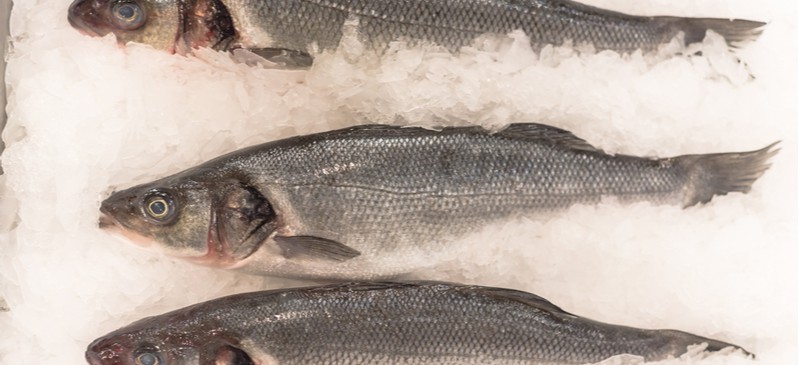
Fish can serve as either a power food or an inflammatory, toxic nightmare for your body, all depending on what fish you choose. That why it’s so important to pay attention to (and avoid) the fish you should never eat.
It’s incredibly important to get ample omega-3 fatty acids, and certain fish can serve as potent sources. But due to issues like mining, sewage and fossil fuel emissions, heavy metals like mercury are winding up in the water and building up in our fish. Unfortunately, low-level mercury poisoning from contaminated seafood is a real threat and can lead to devastating effects on health.
Not only that, but some fish have also been so overfished that they are on the brink of collapse, which can have detrimental effects on the ocean ecosystem. Luckily, there are healthy, low contaminant choices with stable populations that serve as much smarter choices.
Let’s take a look at fish you should never eat, plus a few healthier options for best fish to eat.
Fish You Should Never Eat
1. Tilapia
Did you know that in some regards, eating tilapia is worse than eating bacon? In fact, the shift to eating more farmed fish like tilapia is leading to highly inflammatory diets, according to a 2008 study published in the Journal of the American Dietetic Association.
Wake Forest University School of Medicine researchers say tilapia is one of the most widely consumed fish in America. The problem with that? It contains very low levels of beneficial omega-3 fatty acids and, perhaps worse, very high levels of inflammatory omega-6 fatty acids. Sustaining high levels of inflammation in the body can worsen symptoms of autoimmune disorders and may be linked to chronic conditions like heart disease, cancer and diabetes.
If you must eat this fish, avoid tilapia from China, where farming practices are particularly worrisome. Better sources are the U.S., Canada, the Netherlands, Ecuador and Peru.
Of course, wild-caught tilapia is preferable to farmed fish but is very hard to find.
2. Atlantic Cod
Historically, Atlantic cod is a species proven to be vitally important to feeding the New World civilization and early colonization of the Caribbean Sea. But the heavy fishing over the last thousand years has taken its toll. In the late 1990s, catastrophe struck: the fishery collapsed.
Although the female cod releases more than a hundred millions of eggs, only a few are able to survive to adulthood. According to Oceana, scientists agree that North Atlantic food webs have fundamentally changed as a result of the Atlantic Cod collapse, and the species is currently considered vulnerable to extinction.
If you’re a fan of cod liver oil, make sure it’s not sourced from Atlantic cod. Instead, opt for Alaskan cod caught with a longline, pot or jig.
3. Atlantic Flatfish (Atlantic halibut, flounder and sole)
Due to historical overfishing and high contamination levels, these flatfish species have secured their slot on the list of fish you should never eat.
In 2014, Oceana, the largest ocean conservation group in the world, conducted an investigation using data from the National Marine Fisheries Service. It identified the nine worst fisheries in the U.S. based on “wasted bycatch.”
They found that commercial fishermen in the U.S. throw about 2 billion pounds of “bycatch” overboard each year. That’s equivalent to about half a billion seafood meals. The California gillnet fishery that targets halibut was identified as one of the worst. According to the report, if you’ve eaten U.S. halibut, there’s a good chance it came from this damaging fishery.
4. Caviar
Beluga sturgeon are ancient fish that are highly sought for their fish eggs, aka caviar. In fact, this fish grows to be very large, can live to be 100 years old and can carry several hundred pounds of caviar, which can be worth up to $3,500 a pound.
According to Oceana, the fish that produces this prized caviar is in major trouble:
It is completely gone from several seas/rivers in which it used to live, and scientists fear that it is critically endangered. In other words, it is very highly vulnerable to extinction across its entire range. Without further protection and enforcement of existing efforts, we may forever lose one of the biggest, most interesting fishes in the world.
If you absolutely cannot give up caviar, Seafood Watch recommends caviar from blue sturgeon raised in recirculating aquaculture systems in the U.S. as a more sustainable alternative.
5. Chilean Seabass
Actually named the Patagonia toothfish, seafood distributors started marketing this deep-sea predator fish as “Chilean seabass” because it sounded less intimidating. It worked. Now common on menus around the U.S., Chilean seabass overfishing has left this species in serious trouble.
Aside from overfishing, its high mercury levels are also problematic. Furthermore, harvesting the fish from Chile is also plagued by poor management and bycatch problems.
6. Eel
Monterey Bay Aquarium’s Seafood Watch places eel on the “Avoid” list on its sushi guide because it’s slow to mature and has been overfished in many parts of the world, bringing some populations to collapse.
This is leaving even Asian countries looking to American eels, which are threatened among U.S. populations, too. That’s a problem because eels are incredibly important when it comes to protecting our water supplies. In the Delaware River, for instance, eels are an integral part of spreading mussel populations that serve as natural water filters.
Aside from the issues with overfishing, eels tend to readily absorb and store harmful chemicals and contaminants such as polychlorinated biphenyls (PCBs) and flame retardants. In certain states like New Jersey, river eels are so contaminated even adults are advised to eat no more than one eel a year.
7. Farmed Salmon
Americans consume a lot of salmon. Unfortunately, the majority is the unhealthiest kind. In fact, most salmon marketed as “Atlantic” salmon is farmed, meaning that fish are raised in conditions often ridden with pesticides, feces, bacteria and parasites.
What’s more, studies show that farmed salmon is more likely to contain harmful contaminants like PCBs, which are pollutants linked to insulin resistance, obesity, cancer and stroke. They’re also often treated with antibiotics and tend to be higher in inflammatory omega-6 fatty acids.
For a better alternative, skip the Atlantic salmon and opt for wild-caught Alaskan salmon instead.

8. Imported Basa/Swai/Tra/Striped Catfish (Often Labeled “Catfish”)
Although these fish are popping up as trendy new menu items all over the United States, what you’re likely getting is a fish called pangasius or swai fish, a much cheaper alternative that wholesales for around $2 per pound.
A 2016 study found 70–80 percent of pangasius samples were contaminated by Vibriobacteria — the microbes behind most cases of shellfish poisoning. Additionally, aside from destroying important river life and wetlands, this fish factory farming method results in fish swimming in waste and sludge. They’re also commonly treated with a broad range of antibiotics, in addition to pesticides and disinfectants.
If you see swai, basa, striped catfish or any type of imported catfish on the menu, run. And take it as a sign that the restaurant isn’t taking seafood safety or sustainability seriously.
9. Imported Farmed Shrimp
Is shrimp good for you? When it comes to farmed shrimp, which accounts for about 90 percent of the shrimp we consume, the answer is a resounding “no.”
READ RELATED: Ginger Tea Benefits for Health, Plus Best Recipe
In 2009, Italian researchers discovered that 4-hexylresorcinol, a food additive used to prevent discoloration in shrimp that could reduce sperm count in men and increase breast cancer risk in women.
Not only that, but all but one of the pesticides used globally in shrimp production are banned for use in U.S. shrimp farms. Shrimp farm ponds are also treated with harmful chemicals and pesticides such as malachite green, rotenone and organotin compounds, all of which can have detrimental effects on health.
Plus, an Associated Press investigation uncovered a slavery network in Thailand dedicated to peeling shrimp sold around the world. In 2007, Thailand alone exported about $1.24 billion to the United States, according to Food and Water Watch.
If you must eat shrimp, Monterey Bay’s Seafood Watch recommends the U.S. farmed version or Alaskan shrimp.
10. Imported King Crab
About 75 percent of king crab sold in the U.S. is imported from Russia, where unsustainable fishing practices are common. Although Alaskan king crab legs legally can only be called that if they’re harvested from Alaska, widespread mislabeling is the norm. For instance, many red king crabs caught in Russia under questionable practices are marketed as Alaskan king crab legs.
Because you should avoid imported king crab at all costs, it’s important to be completely sure of where those crab legs came from before you order them. If the label makes claims like “imported” and “Alaskan,” something is clearly wrong. You can also check out Seafood Watch’s complete crab recommendations for more info.
11. Orange Roughy
One of the longest living marine fish species, orange roughy can live to be 150 years old. Generally known as “slimehead” within the scientific community, seafood marketers had other ideas for this fish and gave the species a more appetizing name. The end result was a severely overfished species.
Since orange roughy don’t reach sexual maturity until at least 20 years old, they are very slow to recovery. According to Oceana: “The extremely long lifespan and the late age at maturity imply that a decimated population may take a half century or longer before it can recover.”
Beyond that, the orange roughy is also known to have higher mercury levels, which can be dangerous if consumed in large amounts.
12. Shark
Sharks are commonly found on fish you should never eat lists for several reasons. As bosses of the sea, they are very high on the food chain. That translates to higher mercury levels you should avoid in both foods and supplements.
But apart from that, most shark species, which are slow to mature and don’t have a lot of offspring, are severely depleted. This is partially due to a high demand for shark fins in Asian cuisine, as well as the fact that sharks are often caught accidentally by the thousands and discarded as waste by tuna and swordfish longline fishers.
13. Atlantic Bluefin Tuna
Although Atlantic bluefin tuna is a highly sought-after sushi ingredient, it’s best to say “no thanks” to this popular fish. Often referred to as Hon Maguro on sushi menus, this simply means bluefin tuna, which should be avoided at all costs. A better sushi choice would be katsuo/skipjack tuna caught through Pacific troll or pole and line methods only.
Atlantic bluefin tuna lands on the fish you should never eat land for a few reasons. First, it’s been overfished to the point of near extinction. However, due to its high demand for sushi, fisheries managers are still allowing commercial fishing to target it.
Sadly, bluefin tuna numbers are at just 2.6 percent of historic population levels. Aside from the obvious population collapse and extinction threat, this is also a large predatory fish that harbors higher levels of mercury.
14. Swordfish
Mercury is the main concern when it comes to avoiding swordfish. This large, predatory fish contains elevated levels.
In fact, the mercury in this fish is so high that the Environmental Defense Fund recommends women and children avoid it altogether. For men, the recommendation is to eat no more than one serving a month.
15. King Mackerel
Mackerel is certainly packed with healthy omega-3s. But when it comes to certain types of mackerel, you could be getting more than you bargained for. That’s certainly the case with king mackerel, as the Food and Drug Administration warns women and children to outright avoid it. You may want to avoid Spanish mackerel, too, which has also been shown to harbor elevated mercury levels.
Luckily, Atlantic mackerel is high in omega-3s, low in mercury and is rated a top choice in terms of health and sustainability.
16. Grouper
Grouper is on the list when it comes to fish you should never eat due to its moderately high mercury levels. This species is also highly vulnerable to overfishing.
Grouper is also the common target of seafood fraud. In 2015, an investigations found that more than a third of 19 restaurants in Atlanta sold pangasius (also known as “Vietnamese catfish”) as grouper.
Testing also found that “grouper” for sale is actually often king mackerel or whitefin weakfish, a cheaper alternative. Between one-fifth to more than one-third of the halibut, grouper, cod and Chilean seabass samples were mislabeled.
17. Sturgeon
Although Beluga sturgeon are especially targeted for their eggs, other sturgeon are at risk as well. Some even appear on restaurant menus. According to the International Union for Conservation of Nature, sturgeon are “more critically endangered than any other group of species.”
Healthier Fish Options
The best fish options are ones that come from sustainable fisheries, are low in contaminants and high in omega 3 fatty acids. Monterey Bay Aquarium’s Seafood Watch calls this the “Super Green List.”
The fish that fit this healthiest fish bill include:
Wild-caught Alaskan salmon
When you choose wild-caught Alaskan salmon, you get to enjoy the true salmon health benefits. In addition to being rich in heart-healthy fats, salmon is a great source of protein, B vitamins, potassium and selenium.
Pacific Sardines
Sardines serve as one of the highest omega-3 fatty acid sources on the planet. Because they are a fish lower on the food chain, contaminate levels are low. Sardines are also brimming with essential nutrients, including vitamin B12, vitamin D, calcium and selenium.
Atlantic mackerel
This oily fish is also high in health omega-3 fatty acids, along with protein, niacin, selenium and vitamin B12. Keep in mind that mackerel is often sold preserved in tons of salt, so be sure to soak it and rinse well before cooking and eating to reduce sodium levels.
Better Seafood Choices
Although they do contain moderate amounts of mercury, these fish also provide between 100 and 250 milligrams per day in omega-3s and are classified as “good choices” by Seafood Watch:
- Albacore Tuna (troll- or pole-caught, from the U.S. or British Columbia)
- Sablefish/Black Cod (from Alaska and Canadian Pacific)
Related: 15 Best Fish to Eat, Plus Recipe Ideas
Final Thoughts
- Finding safer seafood can be challenging and requires you to consider many factors, including sustainability, nutritional value, mercury levels and the risk of contamination with pollutants, pesticides or harmful chemicals.
- In addition to avoiding the fish you should never eat listed above, you can also use the handy seafood guide app from Monterey Bay Aquarium’s Seafood Watch to find more sustainable choices.
- Be sure to also support Seafood Watch restaurants and business partners to source and put your dollars behind more sustainable, healthy seafood.
- You can also sign up for news from Food and Water Watch. The nonprofit watchdog group keeps a close eye on the seafood industry.
- Finally, when you do eat fish, opt for things like wild-caught Alaskan salmon, Pacific sardines and Atlantic mackerel.
Source: Dr. Axe | Nutrition





